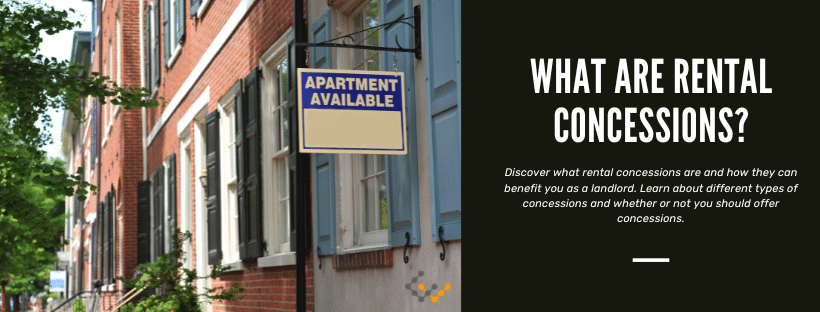What are Rental Concessions and When Should You Offer One?

Commercial property investors need to offer potential tenants attractive terms, or else risk having the best tenants sign leases elsewhere. Rental concessions are one common way to entice tenants with more attractive terms. Here’s a look at what lease concessions are, their advantages and disadvantages, and when you might use them.
What is a Rent Concession?
A rental concession is a temporary or permanent modification of the rent payments and lease agreement. Rent can be modified in many ways, including reduced rates, waived fees, free utilities and more.
The purpose of a rental concession is to entice would-be tenants with more attractive terms, specifically by making a space more affordable. Both residential and commercial landlords may use this strategy.
Answer a few questions and get custom mortgage quotes. We'll match you with offers from our network of 650+ lenders.
Types of Commercial Rental Concessions
There’s no shortage of ways that a creative landlord might modify rent agreements in favor of the tenants. The following are some of the most common types of rent concessions:
- Rent Abatement: A portion of the rent is waived for a certain period of time, usually in the first few months of the lease.
- Reduced Rent: Similar to rent abatement, but the reduced rental rate extends for the entire lease term.
- Free Rent: A certain amount of free rent as an incentive for signing a lease, such as one free month for each year of a lease. The free rent months may be anytime during the lease.
- Waived Fees: Ancillary fees, such as application fees, credit check fees or security deposits, are waived.
- Build-Out: The landlord agrees to complete all or part of a commercial space’s build-out. The tenant might have free rent until the build-out is complete, or there may be penalties if the build-out isn’t completed on time.
- Free Utilities: All or certain utility costs are paid by the landlord. This is generally only considered a concession if the initial lease proposal has the tenant pay these utilities. Otherwise, it’s just part of the original lease.
What are the Pros and Cons of Rental Concessions?
Rental concessions may seem like a benefit only for the tenant, but landlords will find that there are both pros and cons to offering these.
Pros of Rent Concession
- Attracting Tenants: Rental concessions can help attract tenants to your property. Concessions may be necessary in a highly competitive market, or when trying to attract an anchor tenant.
- Filling Vacancies: Rental concessions may help landlords fill vacant spaces more quickly.
- Retaining Tenants: Rental concessions can also be used to retain existing tenants. In addition to the financial incentive, offering a concession can make the tenant feel valued and encourage them to renew their lease.
- Favorable Leases: Landlords might be able to negotiate more favorable terms in other parts of a lease, in exchange for a concession.
Cons of Rent Concession
- Lost Income: Offering a rental concession means giving up some income from the lease agreement. Whether in the form of uncollected rent, missed fees, or increased build-out or utility expenses, all concessions will have a cost.
- Expectations: Offering rental concessions can set the expectation for future concessions. This is especially true if giving a tenant a concession for renewing their lease. Tenants could also all expect concessions if they learn that certain other tenants have received them.
- Limited Time Frame: When concessions expire, some tenants may try to renegotiate when their concession ends. Landlords should be ready to stand by the terms of the signed lease.
What are Some Common Examples of Rental Concessions?
Rental concessions may be used in a variety of situations. The following are a few examples of rent concessions, where they could be helpful to a landlord.
The landlord of a shopping center might offer a concession of a reduced rental rate on a square-footage basis to an anchor tenant. Many anchor tenants expect such a concession, and will only sign leases that have lower rents than what smaller tenants pay. An anchor tenant, of course, is essential to a successful retail property.
If a tenant breaks their lease at the end of summer, the landlord might offer a concession of 2 months free rent to a new tenant. This would allow the new tenant time to gain visibility leading up to the holiday shopping season, while not taxing their cash flow when they have other expenses (e.g. move-in or build-out costs). The tenant should then be able to pay rent once cash flows increase during the holiday season.
If a successful new tenant asks to renegotiate their lease after just 6 months, the landlord might offer a nominal rent abatement in exchange for a much longer lease. This could secure a good tenant for several years. Many new tenants might be initially hesitant to sign a long-term lease before knowing whether they’ll be successful at the location.
What to Consider When Offering Rent Concessions?
As with many other aspects of successfully managing commercial real estate, there’s no one-size-fits-all approach to rent concessions. Investors must consider multiple aspects before deciding whether to offer concessions.
First, the demand for a property should be taken into account. Location is the most important factor in any real estate transaction. Landlords with excellent locations are less likely to need to offer rent concessions, while those with less-desirable locations are more likely to need concessions.
Second, tenant qualifications should be taken into account. A business with a strong rental history and established cash flow could be a great long-term tenant, and may be worth offering substantial concessions. An unknown tenant might not be worth offering concessions, since landlords are taking on more risk of non-payment.
Third, a full cost analysis should be run when negotiating rent concessions in exchange for other lease features. Landlords might find that waiving fees in exchange for shifting utility costs onto the tenant might be in the landlord’s favor over the long term.
Wrapping Things Up
Rental concessions can be a powerful tool for landlords to attract and retain tenants, if used carefully and strategically. If you are considering offering a rental or lease concession, take the time to carefully evaluate the needs of your property and potential tenants. By offering the right concession at the right time, you can maximize your chances of success and create long-term relationships with your tenants.

